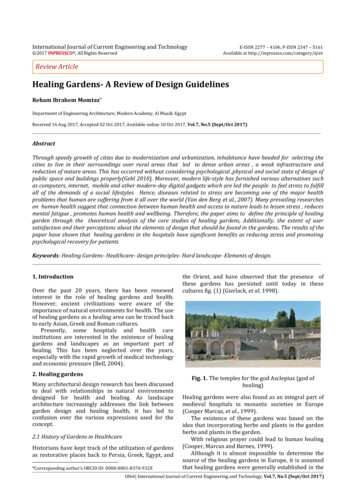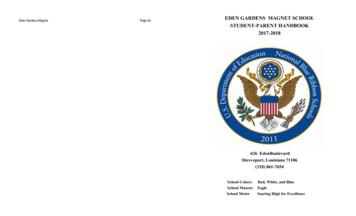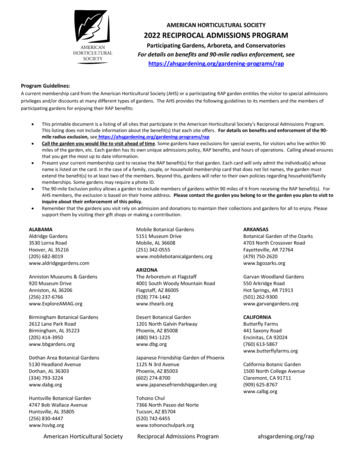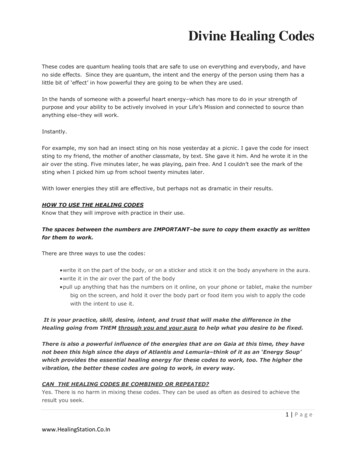
Transcription
International Journal of Current Engineering and Technology 2017 INPRESSCO , All Rights ReservedE-ISSN 2277 – 4106, P-ISSN 2347 – 5161Available at http://inpressco.com/category/ijcetReview ArticleHealing Gardens- A Review of Design GuidelinesReham Ibrahem Momtaz*Department of Engineering Architecture, Modern Academy, Al Maadi, EgyptReceived 16 Aug 2017, Accepted 02 Oct 2017, Available online 10 Oct 2017, Vol.7, No.5 (Sept/Oct 2017)AbstractThrough speedy growth of cities due to modernization and urbanization, inhabitance have headed for selecting thecities to live in their surroundings over rural areas that led to dense urban areas , a weak infrastructure andreduction of nature areas. This has occurred without considering psychological ,physical and social state of design ofpublic space and buildings properly(Gehl 2010), Moreover, modern life-style has furnished various alternatives suchas computers, internet, mobile and other modern-day digital gadgets which are led the people to feel stress to fulfillall of the demands of a social lifestyles. Hence, diseases related to stress are becoming one of the major healthproblems that human are suffering from it all over the world (Van den Berg et al., 2007). Many prevailing researcheson human health suggest that connection between human health and access to nature leads to lessen stress , reducesmental fatigue , promotes human health and wellbeing. Therefore, the paper aims to define the principle of healinggarden through the theoretical analysis of the core studies of healing gardens, Additionally, the extent of usersatisfaction and their perceptions about the elements of design that should be found in the gardens. The results of thepaper have shown that healing gardens in the hospitals have significant benefits as reducing stress and promotingpsychological recovery for patientsKeywords: Healing Gardens- Healthcare- design principles- Hard landscape- Elements of design.1. Introduction1 Overthe past 20 years, there has been renewedinterest in the role of healing gardens and health.However, ancient civilizations were aware of theimportance of natural environments for health. The useof healing gardens as a healing area can be traced backto early Asian, Greek and Roman cultures.Presently, some hospitals and health careinstitutions are interested in the existence of healinggardens and landscapes as an important part ofhealing. This has been neglected over the years,especially with the rapid growth of medical technologyand economic pressure (Bell, 2004).2. Healing gardensMany architectural design research has been discussedto deal with relationships in natural environmentsdesigned for health and healing. As landscapearchitecture increasingly addresses the link betweengarden design and healing health, it has led toconfusion over the various expressions used for theconcept.2.1 History of Gardens in HealthcareHistorians have kept track of the utilization of gardensas restorative places back to Persia, Greek, Egypt, and*Corresponding author’s ORCID ID: 0000-0001-8370-932Xthe Orient, and have observed that the presence ofthese gardens has persisted until today in thesecultures fig. (1) (Gierlack, et al, 1998).Fig. 1. The temples for the god Asclepius (god ofhealing)Healing gardens were also found as an integral part ofmedieval hospitals in monastic societies in Europe(Cooper Marcus, et al., 1999).The existence of these gardens was based on theidea that incorporating herbs and plants in the gardenherbs and plants in the garden.With religious prayer could lead to human healing(Cooper, Marcus and Barnes, 1999).Although it is almost impossible to determine thesource of the healing gardens in Europe, it is assumedthat healing gardens were generally established in the1864 International Journal of Current Engineering and Technology, Vol.7, No.5 (Sept/Oct 2017)
Reham I.amomtazHealing Gardens: A Review of Design Guidelinesfield of health care for the poor, sick and disabledbetween the 10th and 14th centuries (Gerlak-Spriggset al., 1998).By the end of the 1980s and the beginning of the1990s, there had been a decline in the conceptthroughout the world. The connection between healingand nature was gradually replaced by advancedtreatment techniques until the concept of nature wascompletely lost and healed. Beginning in 1990, the ideaof healing gardens gained renewed interest and beganto emerge in the field of medical and sustainablelandscapes researches (Faba, 2002).Today, healing Gardens are gaining popularity dueto stress-related diseases resulting from the harshliving conditions and environmental problems thathumans suffer from all over the world.2.2. Defining Healing GardensHealing garden is the place to reduce stress to the userby using a variety of natural elements with a specificdesign in the garden, which helps restore the mentaland physical state (Faba, 2002).Stark (2004) had a vision, that healing garden as aminiature of the larger world, where every feature ofthe garden is to represent the greatest advantage in thescene. he argued that through this healing modeling itmust be able to "stimulate the senses, improve theimmune response, and promote the relaxation ofphysical and emotional illnesses . The healing gardenis a sacred place keeper, users can reach higher levelsof spiritual strength by having a simple presence Inspace "(Stark, 2004).The American Horticultural Therapy Associationdefinition of Healing garden is a place that helpspatients to recover rapidly, through horticulturaltherapy programs. The concept of healing gardens inthe hospitals : As an a special external environmentrelated to the hospital which is designed to provideparticular therapeutic benefits.2.3. Types of Healing GardensThere are two types of healing gardens as follows:The first type is a therapeutic garden in hospital and ahealthcare centre. Based on the most healingresearches , the positive results of hospital recoveryare related to the patient's time with nature and hispresences in green spaces of a special nature. (Hopper,2007; Faba, 2002; and Marcus and Barnes, 1999). Thesecond type is a private garden that considered as thebest type of meditation garden with healing impact dueto The user has his own space with the most healingbenefits of a garden (Vapaa, 2002).The paper targets the healing gardens in thehospitals to reach the most important elements andfeatures that must be available in the design of healinggardens as a tool to help the architects during thedesign process.3. Healing gardens design criteria for hospitalsWell-designed hospital garden provides pleasant view,lessen stress and improve theraputic results through,enhancing the social support , providing the privacy,and providing opportunities for getting rid of stressfultheraputic conditions (Ulrich, 1999; Cooper-Marcus, etal, 1995).Depending on patients' views ,the healing gardenshould be designed taking into consideration physicalneeds and psychological state (Stigsdotter, et al, 2002).When designing a garden for a hospital , the mainfocus should be on location, accessibility, patients’needs and priorities. Moreover, the garden shouldhave opportunities for mobility and exercise, provide adifferent choices between friendly and personal spaces,and facilitate useful distraction through direct orindirect connection with nature (Stigsdotter, et al,2003).3.1 Design principles of healing gardenMany health care institutions around the world havebegun to integrate therapeutic landscape design withhospital and health care buildings. The healing gardenshave therapeutic benefits, including stress relief, reliefof physical symptoms, and improved overall well-beingfor both patients and healthcare staff. ( Sima POUYA, etal, 2015) .When creating a garden for a health care facility, themain focus should be on the site, accessibility, patients'preferences, and various design elements which suitthe health and psychological state of patients and usersof the garden (Epstein,2006).The healing garden should offer multipleopportunities to encourage the practice of variousactivities and mobility, through the diversity of spacesbetween social and individual spaces that support theinteraction of Patients with nature in direct or indirectways (Marcos et al., 1999).Well designed healing gardens should include somebasic principles related to the psychological state of thePatients as follows (Sherman et al., 2005):Enhance control feelings: Users should be awarethat there is a garden, easy access and use. The Patientsshould feel free to choose between the different andvarious areas. The design of healing gardens shouldinclude special areas that cannot be seen fromoverlooking windows to achieve privacy and a sense ofisolation for those who want to . All or some of the fivesenses can be chosen as focal stimuli in the garden’sconstruction which promote Cognitive performancesand enhance control feelings , (vapaa,2002)A prevalence of green materials and areas: Patients’sense of well-being is promoted by the soft landscape,so the green materials should be dominating in thegarden design also, reducing the hardscape to thelowest level so that trees, shrubs and flowers shouldform about 70% of the garden, with 30% in thecorridors and squares Variety of spaces. as shown infig. (2) (Franklin, 2012).1865 International Journal of Current Engineering and Technology, Vol.7, No.5 (Sept/Oct 2017)
Reham I.amomtazHealing Gardens: A Review of Design GuidelinesFig 2 .landscape and hardscape in Dora Efthim HealingGardenEncourage exercise: The designs should provide ease ofaccess and a sense of independence, as well as relievethe feeling of stress by providing structural elementssuch as walking paths for patients to encourageexercise and play areas for children patients in fig. (3)(Seversen et al., 2013).Minimize intrusions: Healing gardenshould bedesigned to reduce negative factors such as urbannoise, smoke and artificial lighting, for the benefit ofnatural lighting The gardens must contain a variety ofstrongly scented flowers with bright colors that satisfydifferent senses for patients and (although stronglyscented flowers and other scents should be avoided forchemotherapy patients) (Franklin,2012), and alsoAccess to privacy refers to an individual’s ability to findspaces of solitude in the garden.Access to Nature refers to environmental andnatural features that help to relieve stress for patientsand users through their restorative influence Naturaldeviations such as green spaces, flowers, water, andsunlight are believed to strengthen the restorativeeffect of garden users, promote psychological recoveryand improve The therapeutic results of patients.(Ulrich, 1999).Fig. 3 . ramp over a sand play area becomes a featurein itself in this universally designed children’s play areaFig . 5. Natural distractions such as plants, flowers andwater features decrease stress levels.Social support: Communication with other patients andfamily members in the garden enhances the emotionalstate of the patients (Branan & Fest, 1997; Ulrich,1999). Social support can be facilitated by the design ofa healing garden that encourages conversations andsocial networks between groups of patients andvisitors .Fig. 4 (Ulrich, 1999).3.2. Hard landscape design3.2.1. Gateways and entrancesGateways and entrances should be designed towelcome patients and users when they arrive. This canbe achieved through colorful and interesting plants andalso, the work of arts can be organized the primaryaccess focuses and makes a feeling of place. (Shackell,et al. ,2012). The comfortable and varied seats shouldbe considered between fixed and mobile In addition,utilization of guide signs should be found in the gardento guide them to find their way around the site.(Main, ,et al.,2010).3.2.2 PathsFig. 4 . There are private areas where people can bealone in the gardenDirect paths is one of essential elements In the healinggarden additionally, paths should be avoided rightangled corners , slopes of the designed paths shouldnot exceed 30.5cm of rise for a length of 6m and crossslopes should not exceed 30.5cm of rise for a length of1866 International Journal of Current Engineering and Technology, Vol.7, No.5 (Sept/Oct 2017)
Reham I.amomtazHealing Gardens: A Review of Design Guidelines15.24m. Where the slope does exceed 1/20, thereshould be a support railing to preclude slipping.The surfaces of paths should be firm and smooth(Queensland Health,1999(.The principle circulation routes should be plainlyshown, by giving effortlessly comprehended names tothe primary path or having colored lines along the pathor using lighting along the path to designate the mainpaths; (NHS Estates, 2005).3.2.3. Children’s gardensChildren often have tension and stress from thetreatment in hospitals ,So, there must be separatespaces where they can move freely as they need orwant (Nord, et al., 2009). Creative play areas should beavailable to improvecognitive performance.Additionally, the availability of many spaces play areasprovide to children the freedom to choose andencourage them to move which lead to improvetherapeutic results (Verderber, et al. ,2006)(Stephen and et al. ,2006). Other sensible indictors, forexample, capable of being heard water, highlights andwind rings may likewise be utilized to help routefinding for the outwardly disabled in the garden.Lighting: The main role of lighting is to improvewellbeing, help avoid accidental falls, and enhance thesense of safety. The lighting should be placed in thechanging levels of corridors , slopes and stairs in thegarden, in addition to the appropriate lighting indifferent areas in the garden to support the sense ofsafety and give an aesthetic look to the patient throughhis room (Marcus, et al. ,1995)3.3. Planting designArtworks form as a part of the healing environment,which reduce the stress and improve the creativeabilities of patients . artworks could be incorporatedto fit with specific spaces into the garden. On other side, utilizing from artworks to create an engaging focalpoint for the garden and positive message, but withoutuse complex or abstract forms which caused confusionfor patientsNative plants with varied densities should be utilizedin healing gardens which attract butterflies , stimulatethe patients' senses with their colors and sounds andraisepatients'spirits (Shackell et al.,2012).Seasonally changing flowering trees and plantsconduct a comforting consciousness of life’s cycles(Marcus, Clare,1999).Large trees provide shade insummer and shelter in winter Moreover help toimprove the local climate and lessen the airtemperature. In gardens for children or patientsshouldn't contain thorny plants and also, plants thatdrop fruit or leaves that might comprise a hazard .Moreover, Low shrubs and dense, dark greening walls,that conceal the view ,should not be planted close topaths ,instead, these areas should be planted by variedwild flowers and shrubs to promote the sensoryaspects of nature (Shackell et al.,2012).3.2.5.Water4. Need to explore the principles of Healing GardenHearing the sound of running water in fountains و thereflection of the sun on it or seeing the fish in the lakehas a positive effect onthe patient (Verderber, et al. ,2006), Moreover, the sound of running water helps toreduce external noise from space and creates sensoryfocal points for garden spaces that attracts all ages andabilitiesPresenting the core objective of healing gardensprinciples adopted of a number of design guidelineswhich aims to maximize the ability of healing gardensto meet the psychological and functional goals of theprogram through three phases:The first stage is to present specific healing gardendesign features that potentially facilitate each of thefive key outline standards of recuperating the gardenproposed by the Theory of Healing Gardens.The second stage is an analytical study on the extent ofthe effect of gardens on the stress state of patients.The third stage is to present the principles of healinggarden through the basis of theoretical analysis of thecore studies in the field of healing gardens and theextent of user satisfaction and their perceptions of theelements of design that should be available in thegardens.3.2.4. Art3.2.6. Site furnitureThis term refers to free-standing elements such asseats, litter bins, lighting and signs, which should beselected carefully to suite the psychological state ofusers.Seating: should be accessible where people wouldreally need to utilize it, ordinarily shaded andconfronted towards an attractive scene. It should beComfortable and movable. (Main, et al. ,2010).Signage: fitting, agreeable and inviting signs are anunquestionable requirement. Site signage ought toshow, in addition to other things, directional or oneway activity, confinements, stopping, conveyances,understanding passage focuses, doors to offices, etcetera (Epstein, et al. ,2006). Material signs ought to besettled at a stature of 150cm (120cm for children)4.1 healing garden design featuresTables below presents specific healing garden designfeatures that potentially facilitate each of the above fivekey design elements suggested by the Theory ofHealing Gardens, These design features have beencompiled based on seven major theoretical andpractical researches. Selected studies are :1867 International Journal of Current Engineering and Technology, Vol.7, No.5 (Sept/Oct 2017)
Reham I.amomtazHealing Gardens: A Review of Design GuidelinesCooper Marcus and Barnes (1995, 1999), McDowelland Clark-McDowell (1998), Mitrione and Larson(2007), Naderi and Smith (2008), Ulrich (1999)Cochrane, T.G.(2010) and Tseng, W.C., Chang, W.C., &Yi, K.J. (2014).Table 1.Enhance feelings of controlDesign PublishedRecommendations542341122145As shown from Table 2, the factors that mostmentioned with the aid of the seven guides were Thelawn has flora with a spread of colors., vegetation(timber, shrubs, and plants) is the primary portion ofthe garden., designers ought to choose vivid coloringsinside the plant life that trade coloration with theseasons and some plant life inside the lawn enticebutterflies. a précis, garden layout need to have plentyof flowers mainly with awesome species, methodswhich could provide privacy.6Table 3 Social support42314235Design PublishedRecommendationsprovide areas for conversations insmall groups.Plenty of seating availablemovable seating.central space for gatheringtable for coffee or foodComfortable Chairs533123Referring to Table 3, 4 sub-elements in this categoryachieved a minimum of 3 number of hits whichincluded areas in the garden for conversations in smallgroups, Plenty of seating available, movable seatingand Comfortable ChairsTable 4 Minimize IntrusionsDesign PublishedRecommendationsTable 2 Access to NatureTotalTseng, , et al.Cochrane,T.GUlrichNaderi ,et al.McDowll et al.personal areas in which patientcan be aloneMitrione ,et al.TotalTseng, , et al.UlrichCochrane,T.GNaderi ,et al.Mitrione ,et al.Cooper , et al.McDowll et al.Design Feature ItemDesign Feature ItemCooper , et al.Design PublishedRecommendationsTotalBased on Table 1, the most common elementssuggested by the literature were Varity of walkingroutes in the garden, easy to see from hallways in thehospital, The paving of pathways is smooth, differentviews of scenery to choose from in the garden, varietyof choices in spaces within the garden and providesunny and shaded area. According to the result,designers should Provide ease in getting around forusers in wheelchairs, Navigating across the lawn issimple, an expansion of seating arrangement choicesand comfortable seats .Tseng, , et al.21Cochrane,T.G3Ulrich3Naderi ,et al.3McDowll et al.Design Feature Item1Cooper , et al.544Mitrione ,et al.easily visible from the entry.provide an inviting entrance.easy to see from hallways in thehospital.Maps are to be had at uniqueplaces inside the health facilitysignageThe doors are easy to use.The paving of pathways issmooth.Navigating across the lawn issimple.provide ease in getting aroundfor users in wheelchairs.provide an expansion of seatingarrangement choices.comfortable seatssunny and shaded areas.Avoid glare from light concreteentering the garden withouthaving to use stairs or ramps.Varity of walking routes.variety of choices in gardens'spaces.unique perspectives ofsurroundings to choose frominside the garden.fountainrestroom near the gardenTotalTseng, , et al.UlrichCochrane,T.GNaderi ,et al.McDowll et al.Mitrione ,et al.Cooper , et al.Design Feature Itemplants with a variety of colors.spots of bright colors in theplants.plants are pleasant to touch.The vegetation is planteddensely.The vegetation is the majorportion of the garden.The vegetation are appealing.The plants have a nicefragrance.variety of types of plant life thegarden.the choice of flowers fits thislocation/metropolis properly.Provide a few local plantSome plants attract butterflies.41868 International Journal of Current Engineering and Technology, Vol.7, No.5 (Sept/Oct 2017)
Reham I.amomtazHealing Gardens: A Review of Design Guidelinessome personal seating regionshidden with the aid of vegetationprivate places.a sense of enclosure from theoutside the world.a sense of enclosure from thehospital environmentthe scale of the garden is bigsufficient to keep away fromnoiseprivacy from on-looking patientrooms.213242As proven from table 4, the elements that maximumnoted were personal areas where in humans can bealone, there may be a sense of enclosure from theoutside global and the size of the garden is big enoughto avoid noise.Table 5 Encourage exercise613311In table 5. the most common factors counseled throughthe literature have been provideregions thatencourage exercising thru strolling, narrow andcurving strolling paths for slowly on foot andmeandering and Play place for children.4.2 Analysis of users' ResponsesThe strategy for proceeding users' interviews(patientstaff and families of patients) in children's cancerhospital were semi-organized users’ interviewsoccurred between the hours of 10:00 am and 5:00 pm.The researcher asked and interviewed with fifty. Eachmeeting kept going no longer than ten minutes. theinterviews were directed independently to have afirsthand comprehension of requirements and toensure data integrity. The participants' responses wereanalyzed in terms of their perceptions of satisfactionwith the indicators for healing gardens Table 6. Andtheir perceptions of the design elements that must beavailable in the gardens and their impact on thepsychological state of them Table (7).PatientsStaffFamiliesofPatientsStress reducing featuresSense of controlPhysical movement and exerciseOpportunities for social supportSpaces for significantassociations with friends andfamilyTable 7 Design Elements in Relation to Goals of theHealing ity of plants.easily visiblefrom the entry.waterfallbirdsVarity ofplants.Varity ofplants.N/AN/ApathspathsN/AOpportunities forsocial supportPlenty of seatingResting action withfriends and familynone citedN/ApathsObjectives of ahealing gardenSense of controlTotalTseng, , et al.UlrichCochrane,T.GNaderi ,et al.Mitrione ,et al.Cooper , et al.McDowll et al.provide areas that encourageexercise through walking.diverse sorts of taking walkspaths.narrow and curving walkingpathsPlay area for childrenregion for gardening and therapyPlaces for exercise and workoutObjectives of a healing gardenStress reducingfeaturesDesign PublishedRecommendationsDesign Feature ItemTable 6 Essential Objectives of a Healing Garden forDifferent User GroupsPatientsPhysicalmovement andexercise4.3 DiscussionsThe most discussed design recommendations (thingswhich were specified more than 3 times) from thereviewed literature and users' interviews can beabridged as takes after.A-SeatingWhile choosing furniture for patients, the physicaldelicacy of the patients must be considered. healinggarden ought to have a lot of seating with variousforms, for example, those with arms and backs andfurthermore seating which are moveable. Other thanthat, the patients lean toward zones with overheadshade which enabled them to remain outside withprotection from the hot sun.B-Pavement MaterialPatients regularly feel powerless. Along these lines, agarden space should be safe. Material of the asphaltmust be non-slide and non-glare with indeed, even andsmooth surface which will be simple for wheelchairclients to move around. Handrail ought to be givenalong some walkway.C-ActivitiesGive open air exercises, for example, healing gardenhas been appeared to have positive advantages to1869 International Journal of Current Engineering and Technology, Vol.7, No.5 (Sept/Oct 2017)
Reham I.amomtazHealing Gardens: A Review of Design Guidelinespatients . Other than that, horticultural treatment isconsidered as a therapeutic system which may enhancememory, consideration, feeling of obligation and socialassociation. Moreover, greenery enclosures can giveregions for amusement and exercise purposes, placesfor social exercises and furthermore play area forchildren which are helpful for physical and emotionalwellness of the patients.D-Location of the GardenThe open air plant needs some feeling of walled in areaand the non attendance of feeling that usres are in a"fishbowl" or being gazed at. Along these lines, the areaand introduction of the garden are significant, forexample, the garden ought to be close to the principleentrance and furthermore unmistakable fromfundamental indoor zone.E-Access to NatureMany research had discovered the significance ofmedical advantages for the patients , for example,enhanced mind-set , diminished worry and stress byhaving contact with nature. In this way, a very muchoutlined garden ought to give components that couldurge the patients access to nature, for example, adiffering blend and wildflowers to attract birds andbutterfliesConclusionsthe architects must Focus on integrating all keyelements of healing garden and users' desire thatcreate a quiet environment which reduce stress andpromote patients health. It needs special attention inthe design and continual emphasis by the hospital.The following list is an important elements whichmust be included in the design:1) Climate-controlled areas (i.e., misters to cool andheated floor to produce warmth)2) Strolling ways and exploring trails3) Improve the stream to take into considerationhowever much connection as could be expected.4) Play area to take into consideration patients' andchildren' delight.5) Open area to take into consideration differentexercises .6) Contemplation region for thought and reflection.7) A few water highlights.8) Different seating choices with the greater part inthe one to three seating range.9) Friendly/commonplace components (i.e., wingedanimal feeders, recognizable plants and scents).ReferencesAHRQ - Agency for Healthcare Research and Quality. (2007).Environmental scan of instruments to inform consumerchoice in assisted living facilities. Retrieved cappa.pdfBeal, H., (2004). “Natural Healing.” Architecture Minnesota,30, p. 48-53.Cochrane,T.G.(2010). Gardens that Care: Planning OoutdoorEnvironments for people with Dementia, Alzheimer’sAustralia SA Inc. pp.3-22.Cooper Marcus, C., & Barnes, M. (1999). Healing gardens:Therapeutic benefits and design recommendations. NewYork: John Wiley & Sons.Cooper Marcus, C. & Barnes, M. (1995). Gardens in healthcarefacilities: Uses, therapeutic benefits, and designrecommendations. Martinez, CA: The Center for HealthDesign, Inc.Cutler, L. J. (2000). Assessment of physical environments ofolder adults. In R. L. Kane & R. A. Kane (Eds.), Assessingolder persons: Measures, meaning, and practicalapplicationsNew York: Oxford University Press. (pp. 360–379).Cynthia A. Leibrock and Debra Harris,(2011), Design Detailsfor Health: Making the Most of Design's Healing Potential,2nd Edition, New York: John Wiley & Sons, Inc.Epstein, Mark.,( 2006) Hospital gardens help patients heal,Seattle Daily Journal Health Care Design & Construction, p.p11Franklin, Deborah,( 2012), How Hospital Gardens HelpPatients Heal, Scientific American Magazine, p.p.3.Gierlach-Spriggs, N. Kaufman, R. E., & Warner, S. B. Jr. (1998),Restorative Garden: The Healing Landscape, New Haven,CT: Yale University PressGokcen Firdevs Yucel,( 2013) "Advances in landscapeArchitecture ",Chapter 15 :Hospital Outdoor LandscapeDesign ,InTech, Istanbul.Hopper, L. J., (2007), Landscape Architectural: GraphicStandards. John Wiley and Sons. Inc. Hoboken. New e/13037.pdf(accessed January 2017)John Wiley & Sons Main, Bill and Hannah, Gail Greet.,(2010),Site Furnishings: A Complete Guide to the Planning,Selection and Use of Landscape Furniture and Amenities,John Wiley & Sons, USA.Marcus, Clare Cooper and Barnes, Marni., (1999) ndations.Marcus, Clare Cooper and Barnes, Marni.,(1995),Gardens inhealthcare facilities: Uses, therapeutic benefits, and designrecommendations, The Center for Health Design, IncMitrione, Steve, & Larson, J. (2007). Healing by design:Healing gardens and therapeutic landscapes. Implications:A Newsletter by InformeDesign, p.p. 1-4.NHS Estates. Wayfinding,( 2005), Effective Wayfinding andSigning Systems, Guidance for Healthcare Facilities,Stationery Office Books; 2nd edition.Nord, R. Del.,( 2009), The Culture for the Future of HealthcareArchitecture. Proceedings of the 28th International PublicHealth Seminar.Queensland Health,( 1999), Design Guidelines for QueenslandAged Care Facilities.Sarkissian,W. & Stenberg,B.(2013). Guidelines for planningfor older people in public open space. Nimbin NSWAustralia.Severtsen, Betsy.( 2006), Healing Gardens, Gardens,p.p. eautiful.htmSima Pouya, Öner Demirel,( 2015) ,What is a healing garden?,AKDEN
Today, healing Gardens are gaining popularity due to stress-related diseases resulting from the harsh living conditions and environmental problems that humans suffer from all over the world. 2.2. Defining Healing Gardens Healing garden is the place to reduce stress to the user by using a variety of natural elements with a specific










